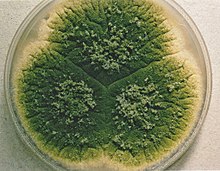| Aspergillus parasiticus | |
|---|---|

| |
| Scientific classification | |
| Domain: | Eukaryota |
| Kingdom: | Fungi |
| Division: | Ascomycota |
| Class: | Eurotiomycetes |
| Order: | Eurotiales |
| Family: | Aspergillaceae |
| Genus: | Aspergillus |
| Species: | A. parasiticus
|
| Binomial name | |
| Aspergillus parasiticus Speare (1912)
| |
| Type strain | |
| UAMH 9603 | |
| Synonyms | |
| |
Aspergillus parasiticus is a fungus belonging to the genus Aspergillus.[1] This species is an unspecialized saprophytic mold, mostly found outdoors in areas of rich soil with decaying plant material as well as in dry grain storage facilities.[2] Often confused with the closely related species, A. flavus, A. parasiticus has defined morphological and molecular differences.[3] Aspergillus parasiticus is one of three fungi able to produce the mycotoxin, aflatoxin, one of the most carcinogenic naturally occurring substances.[3] Environmental stress can upregulate aflatoxin production by the fungus, which can occur when the fungus is growing on plants that become damaged due to exposure to poor weather conditions, during drought, by insects, or by birds.[2] In humans, exposure to A. parasiticus toxins can cause delayed development in children and produce serious liver diseases and/or hepatic carcinoma in adults.[3] The fungus can also cause the infection known as aspergillosis in humans and other animals. A. parasiticus is of agricultural importance due to its ability to cause disease in corn, peanut, and cottonseed.[2][4]
- ^ Cite error: The named reference
ZK1990was invoked but never defined (see the help page). - ^ a b c Cite error: The named reference
bugwood2014was invoked but never defined (see the help page). - ^ a b c Cite error: The named reference
pitt1999was invoked but never defined (see the help page). - ^ Cite error: The named reference
OG1912was invoked but never defined (see the help page).